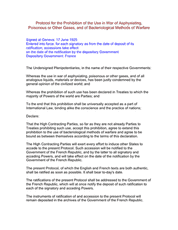Protocol for the Prohibition of the Use in War of Asphyxiating, Poisonous or Other Gases, and of Bacteriological Methods of Warfare (Geneva Protocol)
The Protocol for the Prohibition of the Use in War of Asphyxiating, Poisonous or other Gases, and of Bacteriological Methods of Warfare (Geneva Protocol) was signed at Geneva on 17 June 1925 following widespread use of chemical weapons during World War I.
The Geneva Protocol prohibits the use of chemical and biological weapons during conflicts. However, it does not prohibit the production, storage, or development of chemical and biological weapons, and was consequently followed by the Biological Weapons Convention (1972) and the Chemical Weapons Convention (1993).
| Opened for signature | 17 Jun 1925 | ||
| Entered into force | 8 Feb 1928 | ||
| Latest update | 17 Jun 1925 | ||
| Available languages |
|
States parties
The Geneva Protocol has 36 signatory states and 146 states parties. It entered into force for each state party on the date of the deposit of their instrument of ratification.
Download the data in this table to view any reservations, understandings, and declarations (RUDs). Many states parties have rescinded or modified their reservations since they originally ratified or accessed to the treaty. The reservations included here are current as of 2022.
Country | Status | Signed | Ratified | Entered into force |
|---|---|---|---|---|
| Afghanistan | Party | 2 Sep 1986 | 2 Sep 1986 | |
| Albania | Party | 12 Dec 1989 | 12 Dec 1989 | |
| Algeria | Party | 14 Jan 1992 | 14 Jan 1992 | |
| Andorra | Non-party | |||
| Angola | Party | 30 Oct 1990 | 30 Oct 1990 | |
| Antigua and Barbuda | Party | 1 Feb 1989 | 1 Feb 1989 | |
| Argentina | Party | 8 May 1969 | 8 May 1969 | |
| Armenia | Party | 13 Mar 2018 | 13 Mar 2018 | |
| Australia | Party | 22 Jan 1930 | 22 Jan 1930 | |
| Austria | Party | 17 Jun 1925 | 9 May 1928 | 9 May 1928 |
Party
The state has accepted, approved, ratified, or is otherwise party to the agreement, indicating consent to be bound to the agreement.
Signatory
The state has signed, but not yet ratified or become an official party to the agreement. Where the signature is subject to ratification, acceptance or approval, the signature does not establish the consent to be bound. However, it is a means of authentication and expresses the willingness of the signatory state to continue the treaty-making process. The signature qualifies the signatory state to proceed to ratification, acceptance or approval. It also creates an obligation to refrain, in good faith, from acts that would defeat the object and the purpose of the agreement.
Non-party
The state has not taken any actions with regard to the agreement.
Associate member
The state may have requirements for some of the statutory or non statutory aspects of an agreement, but would not confer all of the obligations of the agreement on the member. Associate members may not have voting rights.
Observer
The state is non-party to an agreement, but has the ability to attend meetings or other discussions, and otherwise participate in activities. Observers may be granted permission to speak at formal meetings.




